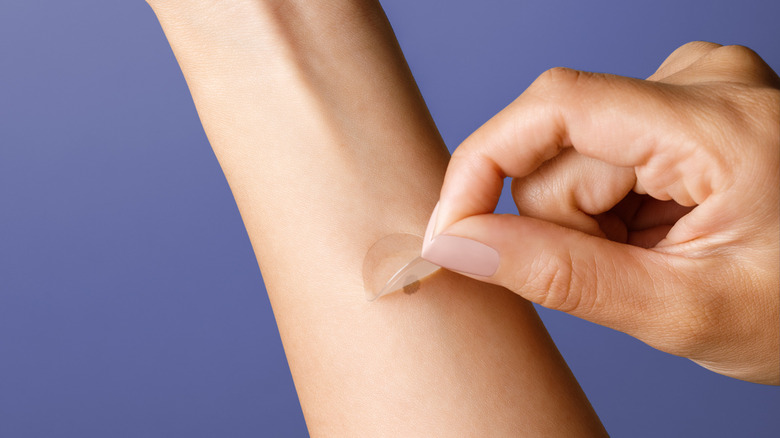Dr. John Dobak On New Ways To Diagnose Melanoma And Preventing Skin Cancer - Exclusive Interview
Melanoma is a type of skin cancer that is very dangerous if it isn't caught early, per the Skin Cancer Foundation. If it's not diagnosed and treated quickly, melanoma can easily, and rapidly, spread to other parts of the body. However, if it is diagnosed early, melanoma is one of the most treatable types of skin cancer. So, it's crucial to get regular checkups and stay on top of suspicious mole growths along with your dermatologist.
Dr. John Dobak, the founder of the biotech company DermTech, has dedicated his career to simplifying the diagnosis process for melanoma so as many cases as possible can be diagnosed before the disease progresses. DermTech's innovative testing technologies leverage the human genome to collect skin cell samples with an easy, non-invasive process and then analyze the samples in a totally new way. This new testing process can help take the guesswork out of melanoma diagnosis and catch the disease earlier than was previously possible.
In an exclusive interview with Health Digest, Dr. Dobak discussed the melanoma diagnosis process and how it's changing, as well as why frequent skin checks are essential, and the best practices for preventing skin cancer.
DermTech is leading the way for medical innovation
Can you tell us a little bit about your background in both medicine and medical innovation?
My career has been a bit untraditional. After I received my license, I moved immediately into the path of entrepreneurship. I started several companies, the first of which was a novel way to treat heart arrhythmias with a cryoablation catheter called CryoCor. Throughout my career, I've dipped my toe in various parts of the medical innovation world, including drug and surgical device development. I'm always interested in identifying and developing creative solutions for the problems we face in medicine.
What inspired you to start DermTech?
I knew that the genomic revolution would be one of the biggest revolutions in medical care. I also knew that melanoma detection was a large-scale problem in dire need of advancement. Marrying the two by developing a non-invasive skin genomics platform felt like the perfect step.
Regular skin exams and early detection are essential
Why is early detection so important for melanoma?
Melanoma is one of the most curable cancers if it's found at its earliest stage. If detected early, the five-year survival rate can be as high as 99%. However, undetected or under-treated melanoma has a survival rate of only about 27%.
What are some of the earliest signs of melanoma?
The earliest signs come in the form of moles that have certain physical characteristics or are constantly changing. The "ABCDE" criteria provides a good framework for determining if a mole should cause concern.
"A," does the mole have asymmetry? "B," are the borders irregular? "C," have you seen any changes in the mole's color? "D," is the diameter bigger than about the head of a pencil eraser? And "E," is the mole evolving? The last piece is possibly the most important, as moles that change over time should be monitored closely.
How do regular skin exams help with early detection and how often should people be scheduling them?
For the most part, once a year is a good cadence to schedule a skin examination with your doctor. This is important because, with formal training and expertise, doctors can identify which moles you should be most concerned about. Plus, they can see places on your body that you can't, such as your back. However, you should constantly be looking at your own skin and moles, particularly ones that fit the "ABCDE" criteria.
Melanoma diagnosis and prevention with DermTech
How has melanoma traditionally been diagnosed?
Typically, doctors will visually assess a mole using a few different tactics. They may use the "ABCDE" criteria or the "Ugly Duckling" warning sign, which refers to identifying the most unique mole on a patient's body relative to their other moles. They may also use a dermatoscope, which acts as a magnifying glass to help doctors take a closer look at any concerning moles.
If it's decided that a particular mole is suspected of melanoma, it will be removed via a surgical biopsy and sent to a pathologist to be examined further.
This is a subjective process and, even at the pathologist level, relies solely on visual assessment. There can be errors that occur along this diagnostic pathway due to the subjectivity of it. With the DermTech Melanoma Test, we use the objectivity of genomics and our non-invasive sample collection to solve this problem.
How have DermTech's Smart Stickers changed the diagnosis process and how do they work?
Cancer is fundamentally a disease of the genome. So, if we want an accurate diagnosis, we should look at what's happening at the genomic level. That's exactly what we're doing with our Smart Sticker™.
We've learned that the cells deep within the epidermis migrate to the skin over about a 30-day period. By applying our Smart Sticker over the mole that's at risk for melanoma, we can measure all genomic changes occurring in the epidermis. Since changes in the genome precede what you can see with the naked eye, uncovering this genomic information is key to a proper diagnosis.
Does this mean no more biopsies for melanoma?
No, there will always be a role for biopsy in the diagnosis of melanoma. The DermTech Melanoma Test is positive between 10–12% of the time. When it's positive, the next step is likely a biopsy. The issue is that most biopsies are unnecessary.
What are some best practices for preventing melanoma and how effective are these measures?
The best thing you can do is avoid direct sun exposure as much as possible and always use sunscreen. There's a strong association between melanoma and UV sun exposure, and an even higher association between melanoma and sunburns.
To learn more, visit dermtech.com.




